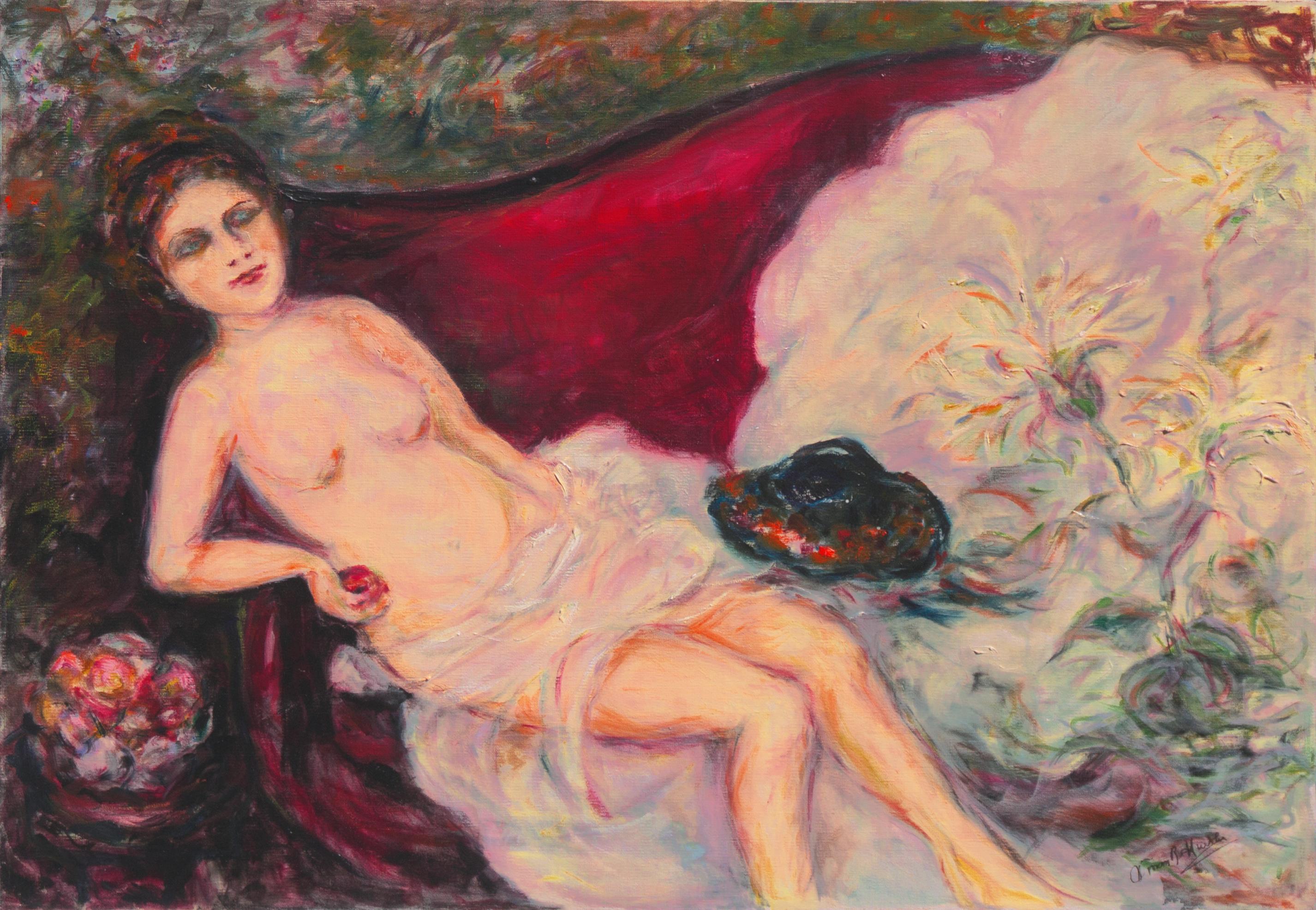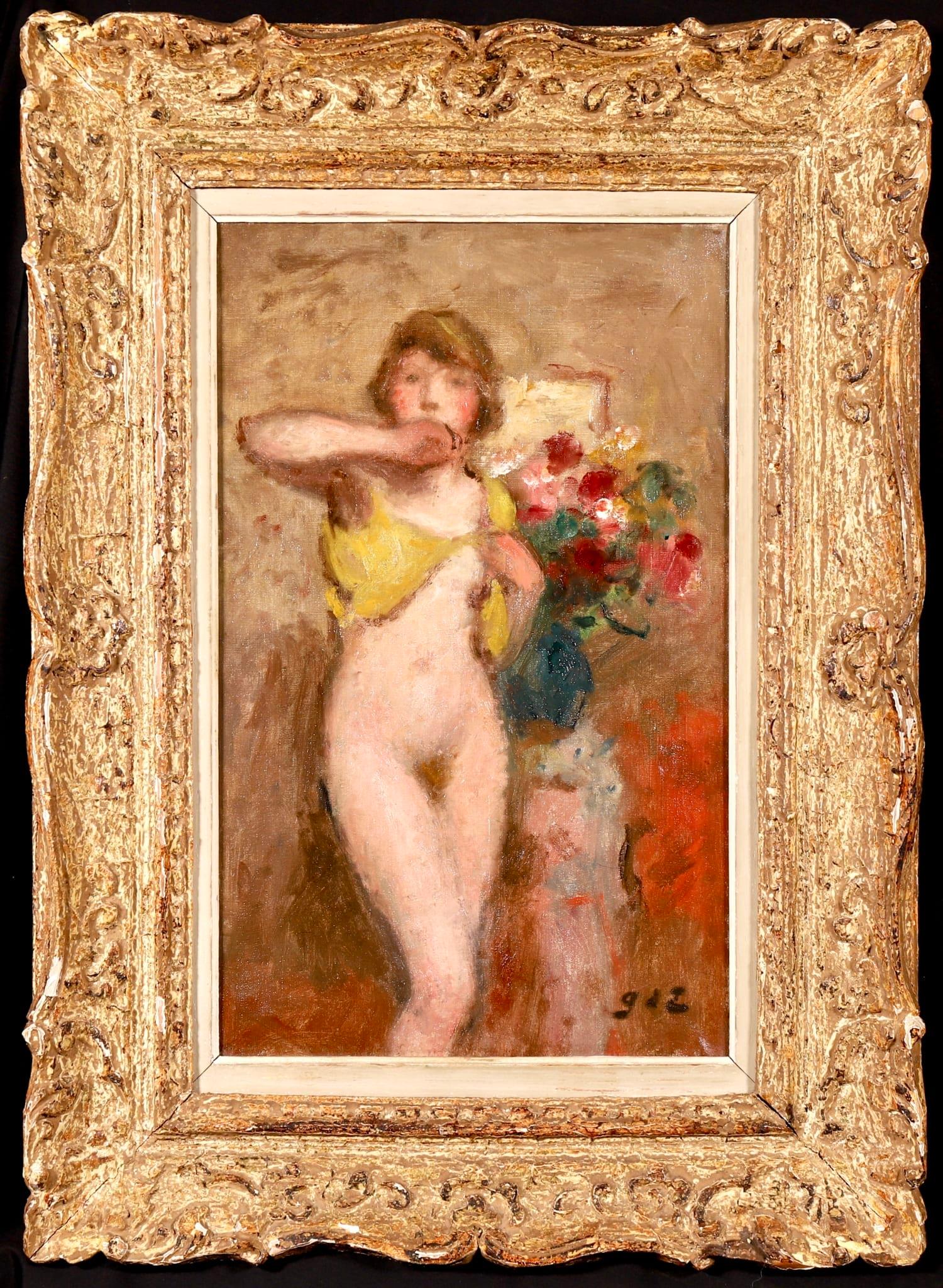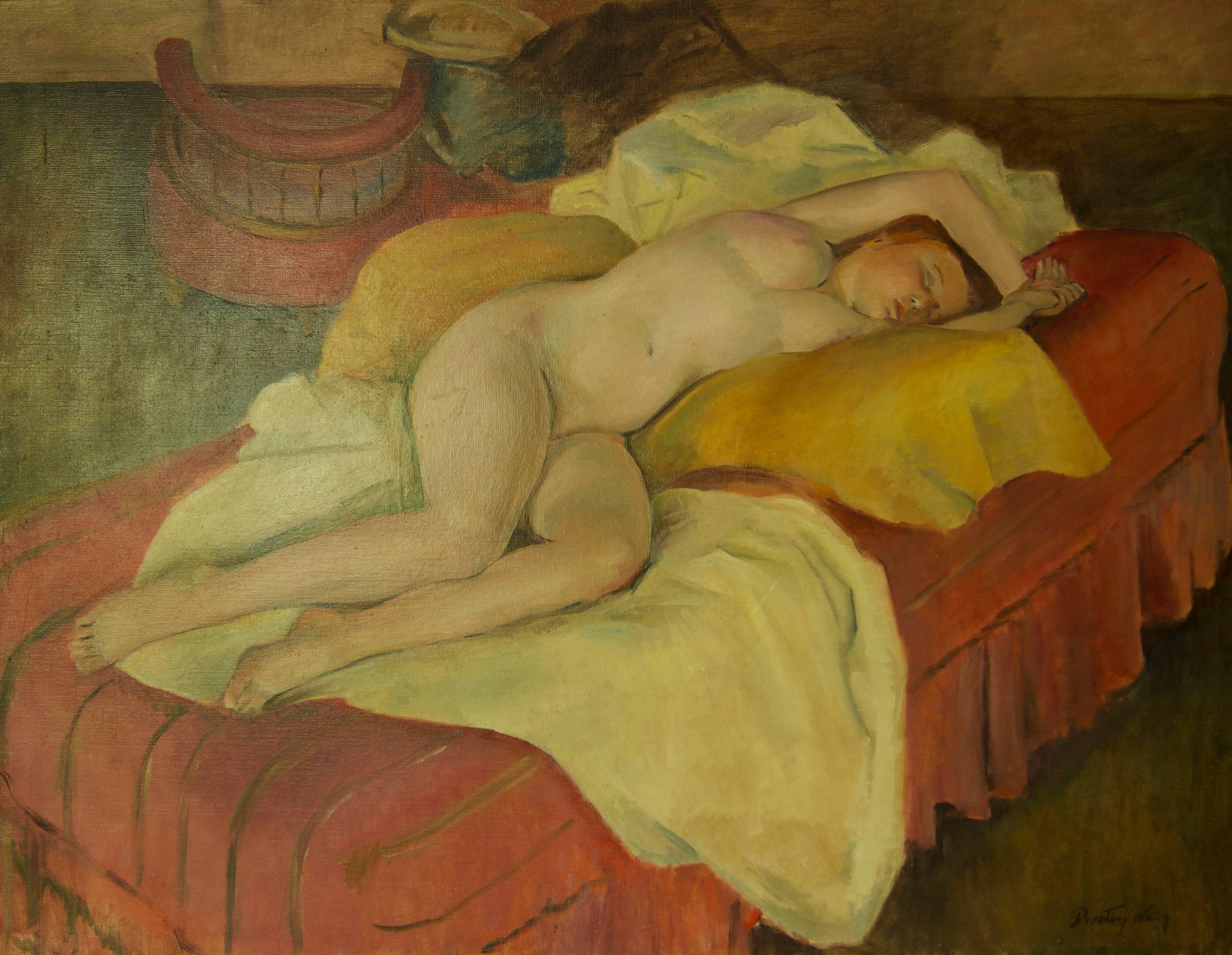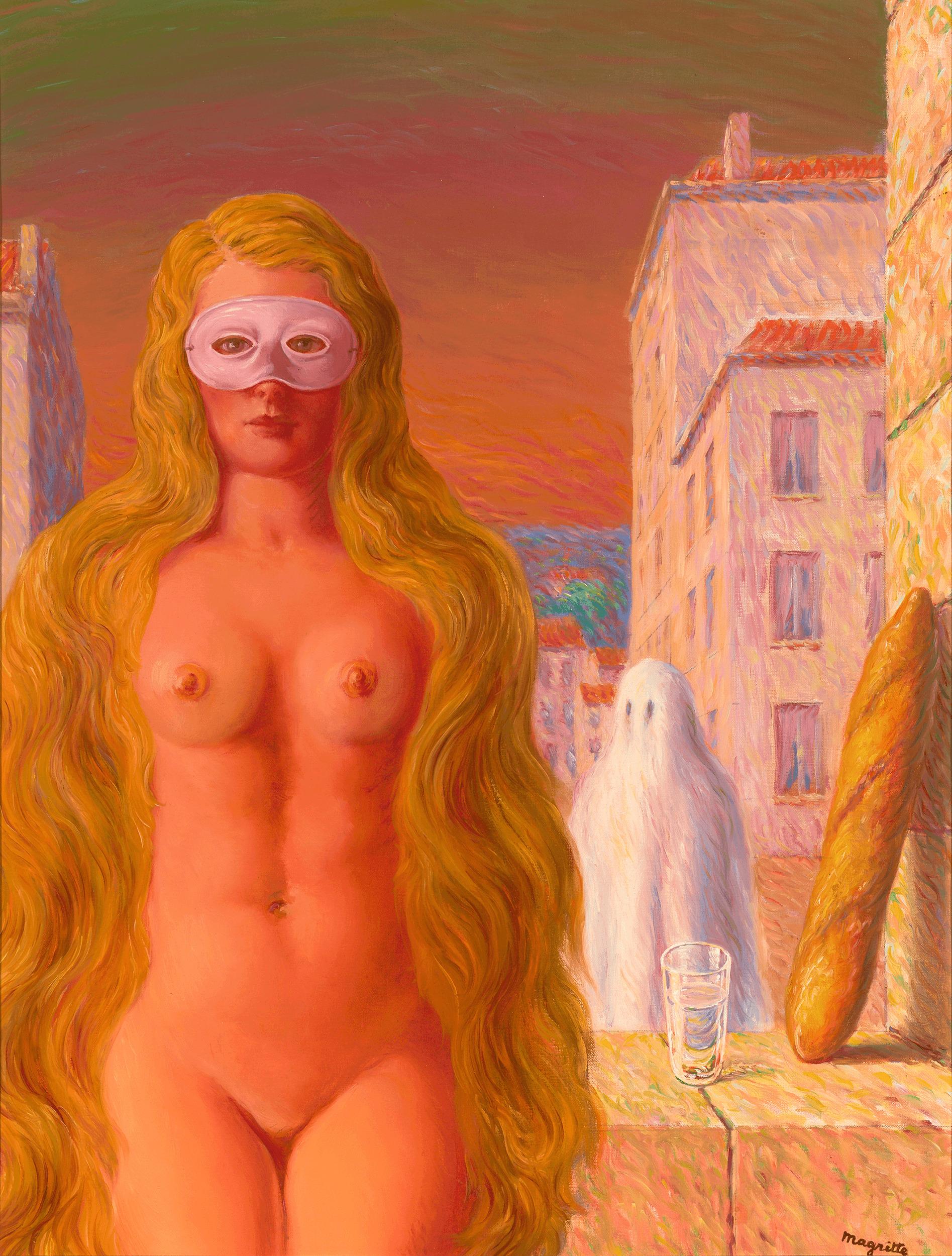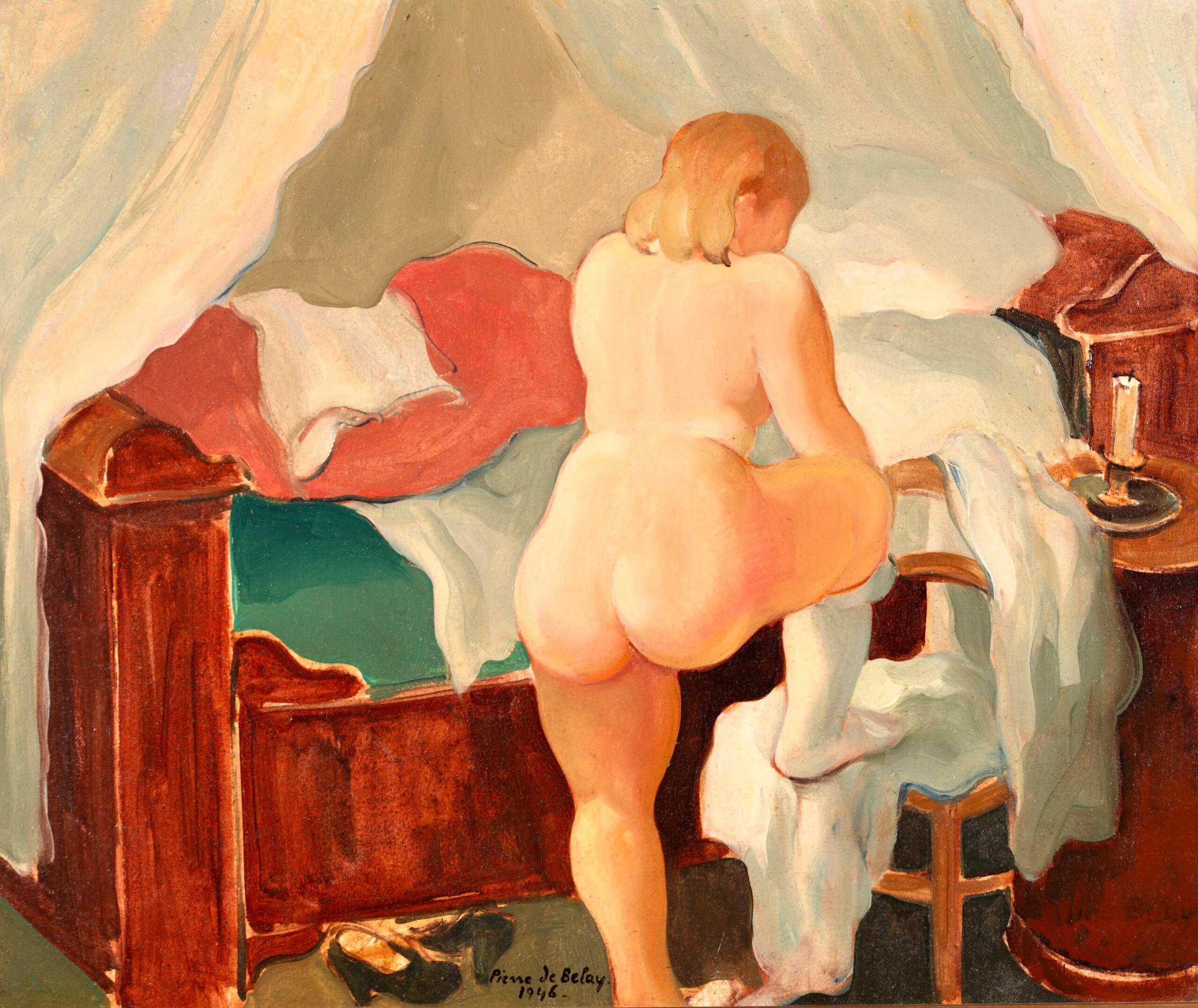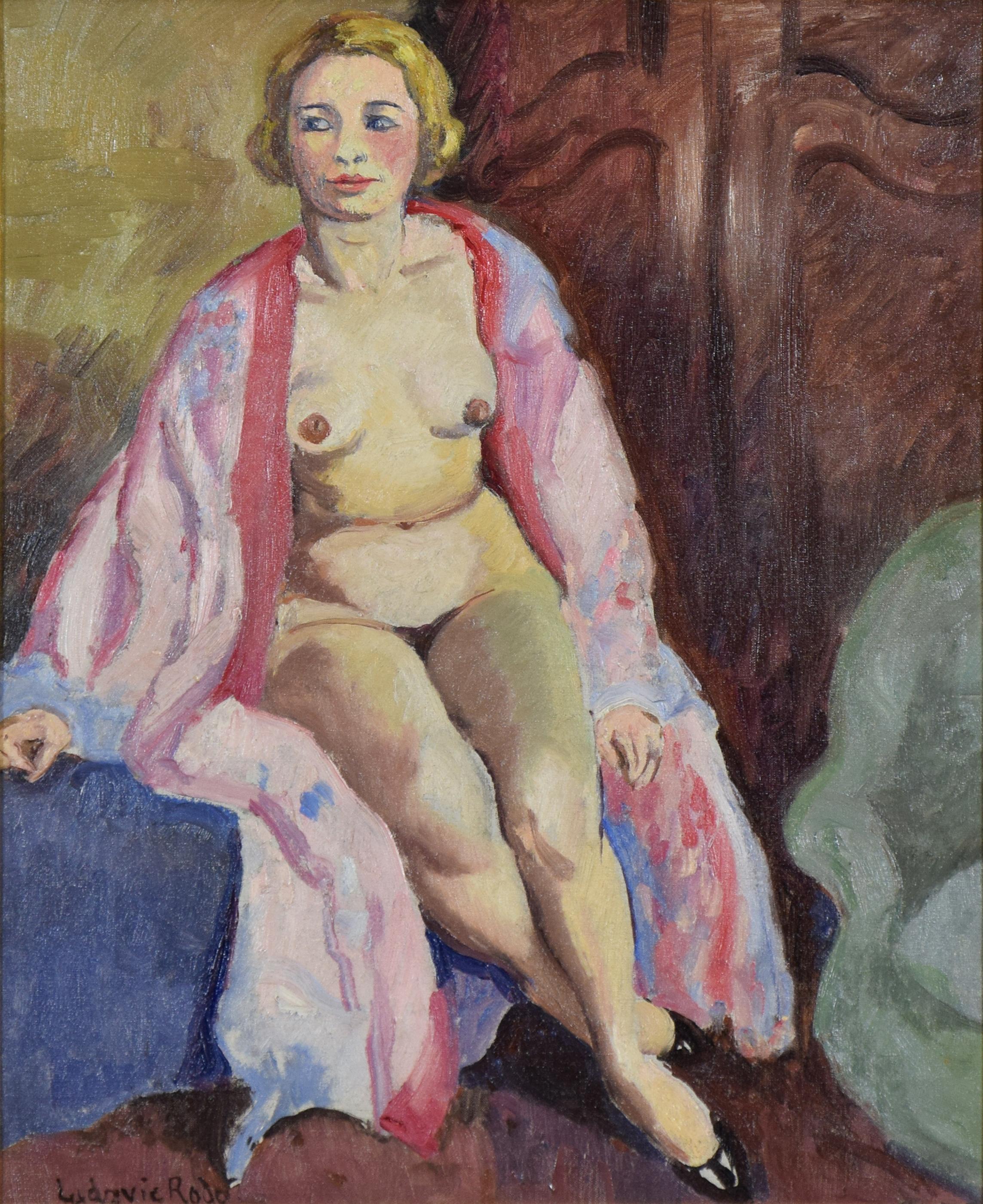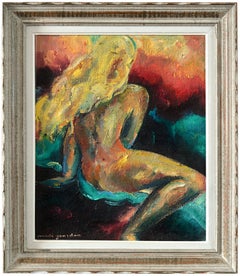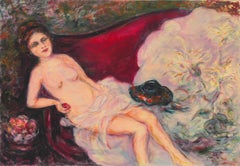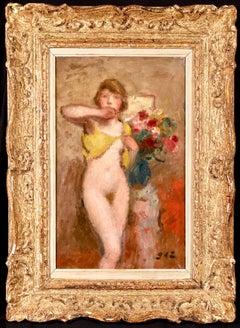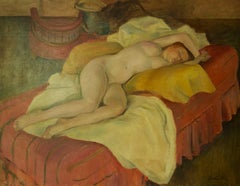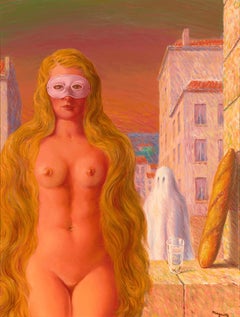Items Similar to Fernande Horovitz-Edwards, Bathers, Large Oil on Canvas, 1930s
Video Loading
Want more images or videos?
Request additional images or videos from the seller
1 of 12
Fernande Horovitz-EdwardsFernande Horovitz-Edwards, Bathers, Large Oil on Canvas, 1930s1930s
1930s
About the Item
Large Oil on Canvas by Fernande Horovitz-Edwards, France, 1930s - "Bathers". This large oil on canvas by Fernande Horovitz-Edwards, titled Bathers, dates from the 1930s and showcases the serene yet expressive style of the artist. Signed "Edwards" in the lower left, this painting captures the timeless beauty of the female form, emphasizing a sense of tranquility and maternal affection.
With frame: 117.5 x 90 x 4 cm (46.3 x 35.4 x 1.6 inches)
Without frame: 114 x 87 cm (44.9 x 34.25 inches)
This work represents a major piece by Horovitz-Edwards, whose universal recognition remains to be fully realized. Born at the heart of the Impressionist movement, Horovitz-Edwards' work, particularly this post-impressionist piece, is deeply influenced by Auguste Renoir. However, it also belongs to the neo-realist current of the interwar period in France, featuring a palette of soft greens and blues reminiscent of artists like Charles Dufresne.
A woman herself, Horovitz-Edwards often painted women, with symbolism being a recurring theme in her works. This painting reflects a serene atmosphere, portraying affectionate maternal moments. It offers a poignant counterpoint to the tumultuous period of the interwar years, marked by resentment, fear, and the indelible consequences of global conflict. In the work of Fernande Horovitz-Edwards, the woman is more than a subject; she is the embodiment of hope, representing the future of humankind.
- Creator:Fernande Horovitz-Edwards (1887)
- Creation Year:1930s
- Dimensions:Height: 46.26 in (117.5 cm)Width: 35.44 in (90 cm)Depth: 1.58 in (4 cm)
- Medium:
- Movement & Style:
- Period:
- Condition:
- Gallery Location:Saint Amans des cots, FR
- Reference Number:1stDibs: LU1088216125742
About the Seller
5.0
Vetted Professional Seller
Every seller passes strict standards for authenticity and reliability
1stDibs seller since 2018
37 sales on 1stDibs
Typical response time: 4 hours
- ShippingRetrieving quote...Shipping from: Saint Amans des cots, France
- Return Policy
Authenticity Guarantee
In the unlikely event there’s an issue with an item’s authenticity, contact us within 1 year for a full refund. DetailsMoney-Back Guarantee
If your item is not as described, is damaged in transit, or does not arrive, contact us within 7 days for a full refund. Details24-Hour Cancellation
You have a 24-hour grace period in which to reconsider your purchase, with no questions asked.Vetted Professional Sellers
Our world-class sellers must adhere to strict standards for service and quality, maintaining the integrity of our listings.Price-Match Guarantee
If you find that a seller listed the same item for a lower price elsewhere, we’ll match it.Trusted Global Delivery
Our best-in-class carrier network provides specialized shipping options worldwide, including custom delivery.More From This Seller
View AllCharles Kvapil, "On the edge of the lake", ca.1920
By Charles Kvapil
Located in Saint Amans des cots, FR
Oil on canvas by Charles Kvapil, France, ca.1920. "On the edge of the lake". with frame: 78x58.5x6 cm - 30.7x23x2.4 inches - without frame: 65x46 cm - 25.6x18.1 inches. 15M format. Signed lower left "Kvapil"
Charles Kvapil was born in Czechoslovakia on November 1, 1884, and died in Paris in 1957.
He takes courses at the Royal Academy of Fine Arts in Antwerp. His first works are exhibited in 1908, at the Salon of Antwerp. In 1911, he exhibits in Munich; his works show a definite cubist influence in a well-tempered, organization and simplification bill. Arrived at a young age in Paris, he sets up his studio in Montmartre in the Hamlet of Artists, between Lepic Street and No. 11 Junot Avenue near those of Utrillo and Valadon; it is there that he will die.
In 1912, he exhibits at the Salon des Independants. In 1914, he presents his works again in Belgium at the Brussels Triennal.
After the war, he lives a very poor life but, with an optimistic temperament, he hopes to break through; he has to work to survive and he paints especially in the evening, especially during his first years in Paris. It is at the Salon des Independants in 1920 that Kvapil is revealed to the Parisian public. He exhibits six paintings: "My campaign", "portrait of woman", "Houseboat", "Poplars", "Bras St. Jean (landscape)" and "Still Life". He is domiciled at 233, rue d'Alésia in Montparnasse."
"In the wake of the legendary figures of Montparnasse, in their shadow, and by them held at a relative discretion (the behavior of artists entering many into the brilliance of their career and the exclusive attachment to their production, without extension" social " " condemning them to darkness), is Charles Kvapil. He frequents the Parnassus café [...] and is exhibited there in a small group organized by A. Clergé, "the Company of professional painters and sculptors", which manifests itself in 1921. The preface is written by Romoff. A second follows shortly. It includes 102 participants, including Friesz, Lagar, Zorate Ortiz, Scouëzec, Astoy, Roysen, Loutreuil, Krémègne, Gallien, Goncharova, Lebedeff, Ramey, Kvapil. He remains attached to the folklore of the Bohemian painter whose Montparnasse is the field of exploits and the model of life "(Jean Jacques Lévêque" The Roaring Twenties, 1918-1939 - The Triumph of Modern Art ", 1992).
He exhibits at the gallery Colette Weill. In 1923, his works are hung at Marcel Bernheim, then at Dalpeyrat, in Limoges, where he shows mostly landscapes. Subsequently, he participates in the Salon d'Automne; to that of 1941, he presents "Phlox", and in 1944 "At the window". In 1951, at the same Salon, he exhibites "Plaisir d'été" and "Le Goûter".
He exhibits during his lifetime in Paris, Munich, Brussels, Geneva, Italy, Stockholm, London and New York.
He is now represented in numerous public and private collections, including the Museum of Modern Art in Paris, the museums of Le Havre, Libourne, Rouen, Saint-Etienne, Amsterdam and Tunis.
Charles Kvapil is known mainly as a painter of characters, especially for his representations of naked women for which his friend Ginette often served as a model; he painted models in the studio, sometimes in front of his window with the Montmartre hill in the background; often bathers or female nudes placed in groups of characters, in the manner of Courbet and the Impressionists at their beginning.
He is also creator of many portraits; but he did not disdain either the still lifes, especially the bouquets of flowers, or the landscapes, which form an important part of his work.
He painted many regions, including Corrèze, where he "knew how to grasp the character of the country that is not his, with his usual mastery" (SSHA Bulletin Corrèze), the Mediterranean coast, Corsica, where he stays regularly in the 1920s and 1930s; in Paris he participated in exhibitions of painters of Corsica in 1925 and 1933. In 1939, at a new exhibition of Art Corse, at the Gallery The Team, still in Paris, he presented two paintings titled "Costa Brugiata, Cap Corsica "and" View of Rogliano ". He is also the creator of "On the Island" (1923), "Querciolo, Rogliano" (1923), "Corsican Woman" (1924), "Landscape of Corsica" (1933) (information Cronica di a Corsica).
Charles Kvapil was influenced by fauvism and a very temperate cubism; Paul Cézanne and to a certain extent Matisse (as a colorist), also marked his style. The desire of construction of the artists of the group to which Kvapil belongs, "did not lead to distortion, except once or twice at Kvapil" .... Kvapil and his friends "thus engaged in thorough technical studies according to the masters, all without exception have loved the beautiful solid and dense material. Their work is related, moreover, not to the classical tradition of transparent painting, but to that of the opaque painting of Frans Hals, Rembrandt and Chardin, almost alone in force since the beginning of the nineteenth century [...] so they paint all in dense pasta but without excessive excess "... (Germain Bazin," the love of art ", 1934).
Charles Kvapil's paintings are original and modern, his nudes and bouquets of flowers are strong and powerful. His palette is rich in cobalt blue and warm colors. His technique is voluntary and powerful. His works in oil are often of modest size, sometimes painted on panels, or on cardboard. He also practiced with great skill the technique of pastel. P. Béran, in a study he has dedicated to him, praises the richness of his material and all that his art owes to the joy of living.
"A work modeled on a life totally devoted to the pleasure of painting. (Jean Jacques Lévêque, ibid.)
He was an indefatigable worker, and this is what he says: "the painter must speak little, but he must comb a lot"
Bibliography
Jean-Daniel Maublanc, Charles Kvapil, painter of figures, 72 p.
Jean-Daniel Maublanc (preface by Louis Parrot), Perspectives - Marcel Lemar, François Eberl, Marcel Roche, Jacques Villon, Charles Kvapil, Charles Jacquemot, Pierre Bach...
Category
1920s Modern Figurative Paintings
Materials
Canvas, Oil
R.B. FELTRAP, Oil on canvas, Nude, 1937
Located in Saint Amans des cots, FR
Oil on canvas signed R.B.FELTRAP, France, 1937. Nude. With frame : 101.5x82.5 cm - 40x32.5 inches ; without frame : 92x73 cm - 36.2x28.75 inches. Format 30F. Signed and dated "R.B.Fe...
Category
1930s Art Deco Figurative Paintings
Materials
Canvas, Oil
Dream
Located in Saint Amans des cots, FR
Oil on canvas by Madé Gourdon, France, 1960s. "Dream". with frame: 70x61 cm - without frame: 55x46 cm. 10F format. Signed "Madé Gourdon" in the lower left. In its frame Montparnasse....
Category
1960s Expressionist Figurative Paintings
Materials
Canvas, Burlap, Oil
$2,800
Edouard Goerg, Les 3 Brunes, Large Oil on Canvas, 1955
By Edouard Goerg
Located in Saint Amans des cots, FR
Large oil on canvas by Edouard GOERG (1893-1969), France, 1955. LES 3 BRUNES. With frame : 114x95cm - 44.9x37.4 inches ; without frame : 92.2x73 cm - 36.3x28.75 inches. Format 30F. S...
Category
1950s Expressionist Figurative Paintings
Materials
Canvas, Oil
Dominique PERY, Marianne, Oil on canvas 1987
Located in Saint Amans des cots, FR
Oil on canvas by Dominique PERY, France, 1987. Nude named "Marianne". 73x60 cm - 28.75x23.6 in. 20F Format. Signed "D.Péry" lower right (see photo). Countersigned twice and dated 198...
Category
1980s Neo-Expressionist Figurative Paintings
Materials
Canvas, Oil
YVES DIEY The Nude, Oil on canvas, 1930s
By Yves Diey
Located in Saint Amans des cots, FR
Oil on canvas by Yves Dieÿ (1892-1984), France – The Nude. A striking oil on canvas by the renowned French artist Yves Dieÿ (1892-1984), depicting a sensual and elegant nude. This wo...
Category
1930s Art Deco Nude Paintings
Materials
Canvas, Oil
You May Also Like
'Reclining Nude', San Francisco Woman Artist, Large Post-Impressionist Oil
Located in Santa Cruz, CA
Signed lower right, 'Vivian R. Huebler' for Vivian Ruth Lewis Huebler (American, 1890-1975); additionally signed, verso, with artist address and painted circa 1955.
Vivian Huebler...
Category
1950s Post-Impressionist Figurative Paintings
Materials
Canvas, Oil
Nu avec des fleurs - Post-Impressionist Oil, Nude & Flowers - Georges D'Espagnat
By Georges d'Espagnat
Located in Marlow, Buckinghamshire
A beautiful oil on original canvas circa 1910 by French post impressionist painter Georges D'Espagnat. The work depicats a nude woman in a yellow shawl standing by a blue vase filled with pink, red and white flowers.
Signature:
Signed lower right
Dimensions:
Framed: 28"x20"
Unframed: 21"x13"
Provenance:
Doyle New York - May 2003
From the beginning of his career, it was a constant concern of Georges d'Espagnet to assert his originality. His studies at the École des Arts Décoratifs, Paris, did not last very long, for he wanted immediate independence and decided to follow courses in the private academies of Montparnasse. In about 1900, he became acquainted with Maurice Denis, Bonnard and Vuillard, and his collaboration with Denis led to a renewal of religious art in France.
In 1903, d'Espagnet was one of the founders of the Salon d'Automne, and was appointed professor in charge of studios at the École des Beaux-Arts, Paris, in 1934. He illustrated a number of books: Rémy de Gourmont's Evil Prayers ( Oraisons mauvaises) (1896), The Saints of Paradise ( Les Saintes du paradis) (1898), Simone (1907), Sistine ( Sixtine) (1922); Alphonse Daudet's The Immortal ( L'Immortel) (1930); André Gide's The Pastoral Symphony ( La Symphonie pastorale); Francis Jammes' Clearings in the Sky ( Chairières dans le ciel) (1948).
D'Espagnet belongs to the group of artists who made the Courrier Français so successful. The drawings of his which are published in it are strongly expressive and some bear comparison with the designs of the great Renaissance masters. He also contributed to L'Image. He often placed cheerful nudes in a landscape, reminding us that, though he moved away from the Fauves, he retained their freedom of colour and arabesque. He painted many portraits, including those of Albert André, André Barbier, Victor Boucher, Déodat de Séverac, Albert Marque...
Category
1910s Post-Impressionist Nude Paintings
Materials
Canvas, Oil
The Model Asleep - Mid 20th Century Nude Still Life Oil Painting by Dorothy King
By Dorothy King
Located in Watford, Hertfordshire
Dorothy King was born and lived in London in 1907. She studied at the Hornsey School of Art under JC Moody, then briefly at the Slade School of Fine Art with Randolph Schwabe. She to...
Category
1940s Post-Impressionist Nude Paintings
Materials
Canvas, Oil
Le carnaval du sage by René Magritte
By René Magritte
Located in New Orleans, LA
René Magritte
1898-1967 Belgian
Le carnaval du sage
(The Sage’s Carnival)
Signed “Magritte” (lower right); titled and dated "Le carnaval du sage 1947" (en verso)
Oil on canvas
The enigmatic paintings of René Magritte have become some of the most familiar and celebrated of the Surrealist movement. Among the most influential of the Surrealist painters of the 20th century, Magritte is an artist of international renown, as beloved for his popular appeal as he is for the psychological intensity of his works. The present oil on canvas, entitled Le carnaval du sage, was executed in 1947 at the height of his career, and it is a tour-de-force example of the haunting, mysterious scenes that comprise his oeuvre.
Painted in the years following the Second World War, Le carnaval du sage showcases several recurring themes from Magritte’s oeuvre. Chiefly, a juxtaposition between the visible and the hidden is keenly felt. Throughout his career, Magritte explores the psychological obsession with revealing what is hidden, particularly with regard to the human face. In his Le fils de l’homme, he obscures the face of a man in a bowler hat with an apple, while his Les amants (Metropolitan Museum of Art) conceals the faces of two lovers with white sheets. In Le carnaval du sage, Magritte juxtaposes the blatant nudity of his central figure by masking her face, simultaneously revealing and concealing her from the viewer.
The work also incorporates two of Magritte’s most common tropes – the glass of water and the baguette. Lending the scene a strange sense of domesticity, they appear infinitely familiar and distinctly out of place, and thus heighten the uncanny effect of Magritte’s composition. In the background hovers a ghost obscured by a sheet, a figure which was of particular fascination to Magritte beginning in 1946. He once wrote to his fellow Surrealist Paul Nougé: "I saw in a dream an answer to the problem of the ghost: the traditional ghost draped...
Category
20th Century Post-Impressionist Nude Paintings
Materials
Canvas, Oil
Price Upon Request
Le Coucher - Post Impressionist Nude in Interior Oil Painting by Pierre de Belay
By Pierre de Belay
Located in Marlow, Buckinghamshire
Signed and dated nude figure in interior oil on canvas by French post impressionist painter Pierre De Belay. This work depicts a painting of Pierre De Belay's wife - Helene. Here she...
Category
1940s Post-Impressionist Nude Paintings
Materials
Oil, Canvas
Nu Assise by Ludovic-Rodo Pissarro - Nude painting
By Ludovic-Rodo Pissarro
Located in London, GB
Nu Assise by Ludovic-Rodo Pissarro (1878-1952)
Oil on canvas
55 x 47 cm (21 ⅝ x 18 ½ inches)
Signed lower left, Ludovic Rodo
Executed circa 1910
This work is accompanied by a cer...
Category
1910s Fauvist Nude Paintings
Materials
Canvas, Oil
